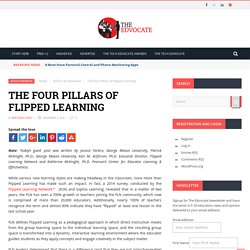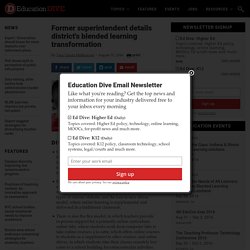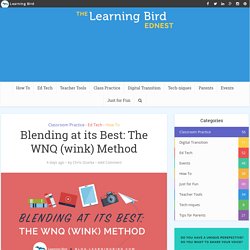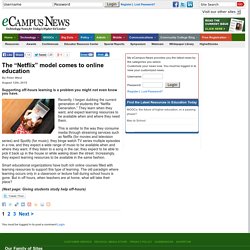Zoom
Trash

The Four Pillars of Flipped Learning. Note: Today’s guest post was written by Jessica Yarbro, George Mason University, Patrick McKnight, Ph.D., George Mason University, Kari M.

Arfstrom, Ph.D. Executive Director, Flipped Learning Network and Katherine McKnight, Ph.D. Pearson’s Center for Educator Learning & Effectiveness. Blended learning: Step by step. Chances are that, by now, you have read something about the effectiveness of Blended-learning environments, about the teachers who employ such learning spaces to enhance student learning, and why they do it.

But that does not bring you, our everyday teacher on the street, much closer to understanding how to integrate blended learning strategies into your teaching, in your school’s context to benefit your students. Luckily, the internet is loaded with resources relevant to blended learning provided by reliable providers (see below).
However, lack of access to tools and tricks is rarely the obstacle stalling curious teachers who approach a new teaching strategy: establishing a new mindset is. Blended Learning Takes Hold in Morristown. Former superintendent details district's blended learning transformation. Dive Brief:

Blended 2.0 shifts learning in schools. A third-grader studying the Spanish settlement of California found a virtual tour online and shared the trip with her classmates by slipping a smartphone into a Google Cardboard viewing device.

Such limitless online resources represent a big, blended leap beyond the essays students in Coalinga-Huron USD in Central California used to write. Blended learning for the district’s 4,400 students began three years ago, and in the past year has gravitated to blended 2.0, says Joe Casarez, associate superintendent for instructional services. “If you define blended learning in the first iteration as a combination of technology and print,” Casarez says, “then what we are seeing when you marry 2.0 personalization with the Common Core standards are more authentic activities in the classroom.” A survey of 1,381 students in the district showed nearly 74 percent were more engaged, and 89 percent agreed they could solve problems or create presentations by researching online, he adds. The result? Diary of a Techy Teacher: Why I’m Taking a One Year Sabbatical with BetterLesson.
Blending at its Best: The WNQ (wink) Method - Learning Bird. More effective than solely face-to-face instruction or solely online classes.

Facilitating a simultaneously independent and collaborative learning environment. Student satisfaction and success. Improved student attitudes toward learning. Ubiquitous learning. Better communication between teacher and student. These are all facets of blended instruction. Beyond the positive effects of setting up a blended learning environment, I believe that the digital and online media, namely videos, will one day be one of most primary ways that new information is spread to learners. It might seem obvious, but what is the best way to teach and learn with educational videos? I have been making educational videos for over seven years now, and I have found that many students simply do not know how to use them effectively at first. After looking at research on education and neuroscience, I created a system that I teach my students to use to best utilize the videos.
Considerations Training Students Watch the Video! Favorite Blended Learning Tools - Go - Teacher Tech. Blending at its Best: The WNQ (wink) Method - Learning Bird. 5 ideas for using Blendspace. Majority Of School Respondents In Ohio Report Using Blended Learning. A big challenge with blended learning is knowing how many students are actually experiencing it. Since we made the prediction in Disrupting Class that by 2019, 50 percent of all high school courses would be online in some form or fashion—the vast majority in blended learning—good data has been hard to come by. The lack of information on numbers experiencing blended learning has created challenges at multiple levels—from understanding if the phenomenon is actually scaling to contextualizing if bumps on the road, like the recent demise of Amplify, are mere blips or catastrophic events, and from understanding where policymakers and philanthropists can make the most impact to knowing whether the blended learning that is occurring is a good or bad thing for students.
A new report released today goes to some measure to tackle this problem in the state of Ohio. Finally, the survey shed light on how schools are navigating the challenges associated with starting new blended-learning programs. The "Netflix" model comes to online education. By Peter West August 12th, 2015 Supporting off-hours learning is a problem you might not even know you have.

Recently, I began dubbing the current generation of students the “Netflix Generation.” They learn when they want, and expect learning resources to be available when and where they need them. This is similar to the way they consume media through streaming services such as Netflix (for movies and television series) and Spotify (for music); they binge watch TV series multiple episodes in a row, and they expect a wide range of music to be available when and where they want. If they listen to a song in the car, they expect to be able to pick it back up in the house or while waking down the street. Blended learning allows flexible schedules for students. Zobott is enrolled in Huntley High's blended learning program, which merges Internet-based instruction with a more traditional classroom setting.

One-third of the school's 2,700 students are enrolled. In 2015, the school is working toward enrolling the majority of its students. "Having to work online makes it really accessible to do the work that I have to get done," said Zobott, a top-ranked junior who balances a heavy load of extracurricular activities with schoolwork. "I can learn on my own. What Does a School Need to Enable Learning Based on Student Competency?
By Jane Mount/MindShift Many teachers have long been frustrated with static, canned curriculum that doesn’t seem connected to kids’ lives, and testing requirements that drive the learning experience.

So they, often in partnership with daring leaders, are pushing back, trying to find ways to meet the long-held goal of educators: Meeting each student’s needs and helping all to be successful. Three main ways schools are attempting this work are through technology use, an emphasis on personalizing learning and moving toward a mastery-based or competency-based evaluation system. While not all the same, these approaches share some commonalities and require significant structural changes to the education system if they are to be implemented well.